This publication provides an in-depth profile of Pinus serotina for academic audiences and interested laypersons with some knowledge of biology.
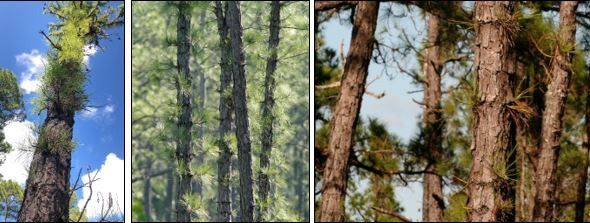
Credit: Left, Lee Cook, iNat [CC BY-NC]; center and right, Mary Keim, iNat [CC BY-NC-SA]
Taxonomy
Family
Pinaceae, pine family. Characterized by having mature seed cones and winged seeds. The leaves are needle-like.
Genus
Pinus, theonly genus of the Pinaceae family native to Florida.
Species
The species name serotina is from the Latin word for “late.” This species produces female serotinous and male non-serotinous cones. Serotinous cones require heat (e.g., from fire) to open and release their seeds for dispersal.
Common Name
The species is commonly known as pond pine, marsh pine, bay pine, or pocosin pine because it tends to be found on poorly drained, very wet sites (Figure 2).
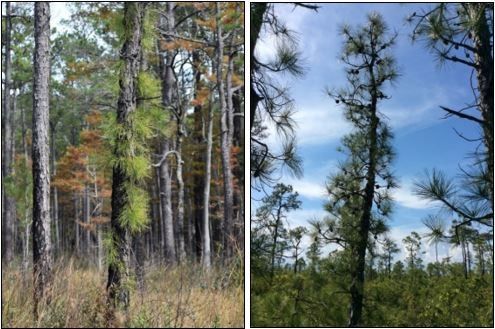
Credit: Left, Sharleen J., iNat [CC BY-NC]; right, Scott Ward, North Carolina Botanical Garden, used with permission
Description
Pond pine is a lesser-known native conifer found along the southeastern coastal plain from New Jersey to central Florida (Figure 3) (Bramlett 1990). Pond pine has a maximum height of 15 meters (50 feet) and an average diameter of 50-60 cm (20–24 inches) (Nyoka 2002). The needles typically occur in fascicles of 3 but may appear in fascicles of 2 or 4 (Bean 2021). Needle length varies between 15 and 20 cm (6–8 inches) (Nelson et al. 2014). The bark is a brown-red color with moderate flakiness. Pond pine grows slowly due to consistent water saturation in its natural habitat that reduces aeration (Bramlett 1990; Graham and Rebuck 1958). Pond pine adapts to anaerobic conditions through the development of aerenchyma and lenticels (Topa and McLeod 1986). An unusual feature of this pine is the epicormic sprouts along its trunk (Figure 4) (Bramlett 1990). When pond pine is stressed, epicormic sprouts from dormant buds appear as a cluster of needles (Archer 2000; Stone et al. 1943) along the bole, or main stem of the tree, as well as from the root collar (Schafer et al. 2015). Pond pine is also known to hybridize with loblolly pine (Pinus taeda) and pitch pine (Pinus rigida) (Bramlett 1990).
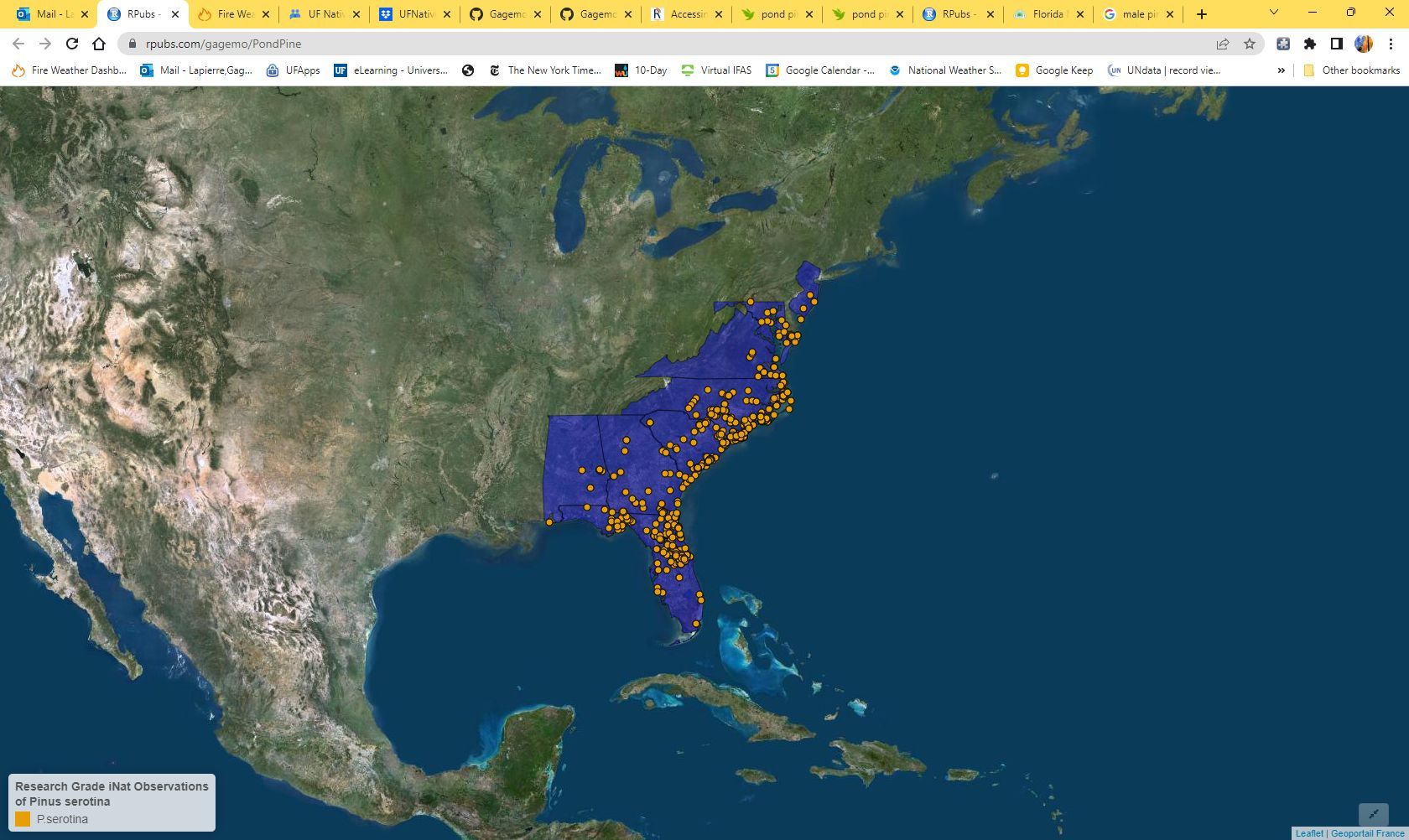
Credit: Map made by Gage LaPierre in R Studio
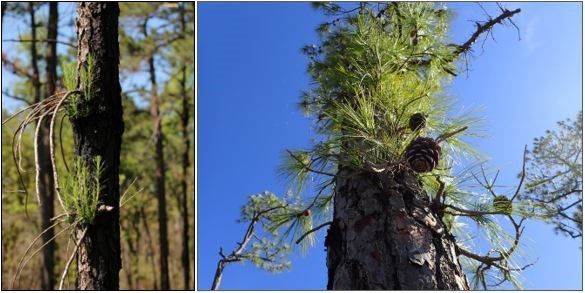
Credit: Left, Scott Ward, North Carolina Botanical Garden, used with permission; right, Austin Pursley (iNat) [PD]
In Florida, pond pine is typically found on wet or poorly drained soils and within the following plant communities (see the Florida Natural Areas Inventory (FNAI) for more on community descriptions): wet flatwoods, shrub bogs or pocosins, baygall, and along the margins of cypress domes and tupelo swamps (Florida Natural Areas Inventory 2010). In these communities, fire plays an important ecological role in maintaining plant composition (Florida Natural Areas Inventory 2010). As result, pond pine appears to possess many adaptations to fire such as serotinous female cones (Figure 5). These cones can accumulate in the crown of tree and may remain sealed with viable seeds for up to 10 years (Bramlett 1990). The resin on the cones melts when exposed to fire, which then triggers the release of seeds for wind-borne or gravity dispersal into freshly burned ground. The conditions following a fire present the ample opportunity for young pines to grow (Proctor and Monroe 2019).
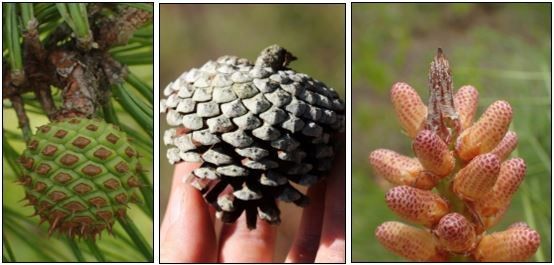
Credit: iNat: left, right Austin Pursley [PD]; center, Scott Ward, North Carolina Botanical Garden, used with permission
Applications
Forestry
Pond pine has limited commercial value due to a typically crooked trunk and slow growth. It is opportunistically sold for pulpwood and biomass, but its form is rarely straight enough for sawtimber (Figure 6) (Nyoka 2002; Graham and Rebuck 1958). There are no major breeding programs for pond pine, and efforts to grow it in other countries for timber have not been successful compared with other pine species such as loblolly pine (P. taeda) and Monterey pine (P. radiata) (Nyoka 2002). It is also susceptible to pitch canker disease (Fusarium moniliforme) and may experience dieback when infected, but it is more resistant than Virginia pine (Pinus virginiana) and slash pine (Pinus elliottii) (Kuhlman and Cade 1985).
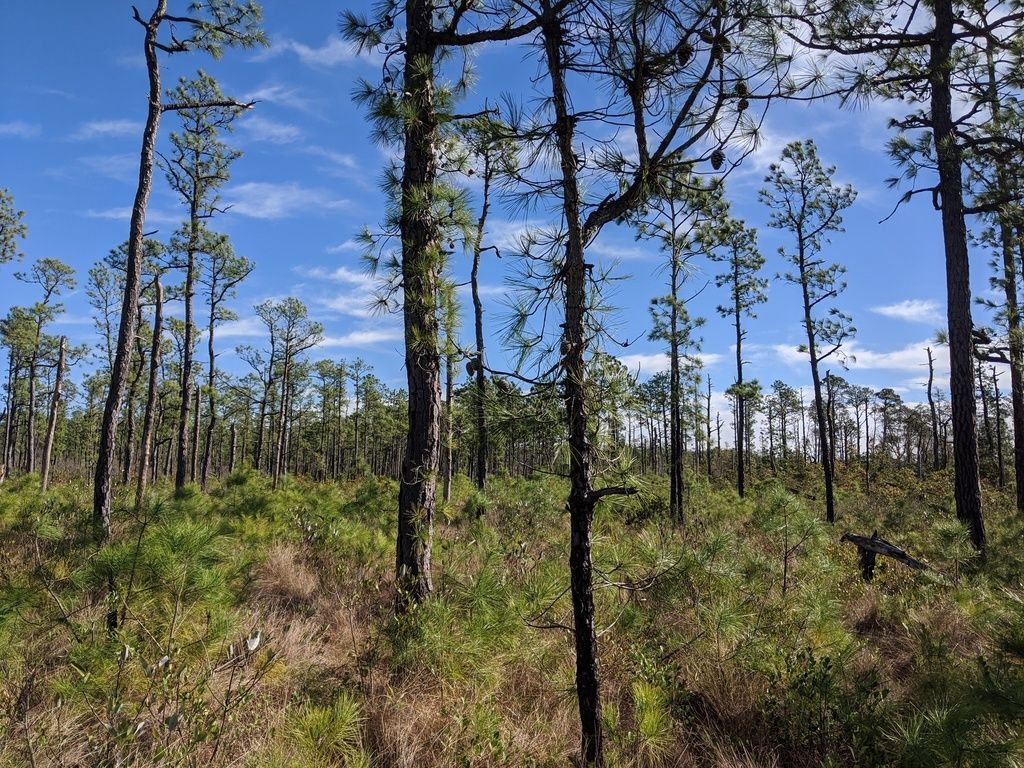
Credit: Austin Pursely, iNat [PD]
Wildlife
Pond pine has a wildlife habitat value similar to that of loblolly pine (P. taeda). However, due to its small diameter, it has less value for cavity nesting birds such as the red cockaded woodpecker (Picoides borealis) than other pines (e.g., P. palustris, P. elliotti,and P. taeda). Natural stands of pond pine provide habitat for amphibians such as the green frog, southern cricket frog, and American bullfrog as well as reptiles such as the plain-bellied watersnake (Hutchens and DePerno 2009).
Propagation
Pond pine is readily propagated by seed (Figure 7) that can be collected from mature unopened cones. Mature cones with viable seeds are brown or deep brown, not green. To open the cones carefully crush them with a metal vice or expose them to dry heat of 167°C to 169°C (333°F to 336°F) for 30 seconds. A light application of fire is also effective to burn off the resin encrusting the cones and allow them to release their seeds (Figure 7).
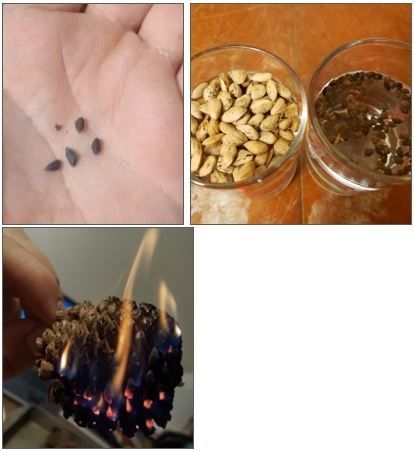
Credit: Left, Gage LaPierre, UF/IFAS; middle and right, J. K. Faylo, used with permission
Propagation Trial at UF Native Plant Nursery: A Case Study
From 2021–2022, pond pine was grown from seed at the UF Native Plant Nursery (Figure 8). The seeds were collected from Mallory Swamp in Lafayette County, Florida, in July of 2021, and sown in August of 2021 outdoors due to this species’ extreme intolerance to shade (Bramlett 1990). Seeds were sown via light press (i.e., 1 cm or 0.4-inch depth) into a soil substrate of peat, perlite, and vermiculite at a 5:3:2 ratio. We used D60 pots manufactured by Anderson Pot Company with a cell diameter of 2.5 feet (about 75 cm) and a depth of 14 inches (about 35 cm). Of the 250 seeds planted, 176 seeds germinated (70% germination rate). Seedlings were fertilized using 1 teaspoon of slow-release pellets of Osmocote Plus 15-9-12 to ensure adequate nutrition. After ten weeks plants averaged roughly 7 inches (18 cm) tall. Plants were then out-planted to the edge of a cypress dome after 16 months and averaged 23.7 in (60 cm) tall at that time.

Credit: Gage LaPierre, UF/IFAS
Works Cited
Archer, A. J. 2000. “Pinus serotina.” In Fire Effects Information System, [Online]. U.S. Department of Agriculture, Forest Service, Rocky Mountain Research Station, Fire Sciences Laboratory (Producer). https://www.fs.usda.gov/database/feis/plants/tree/pinser/all.html
Bean, R. 2021. “Differentiating Between Loblolly, Longleaf, and Other Southern Pines in the Woods.” Clemson Extension Forestry and Wildlife https://blogs.clemson.edu/fnr/2021/07/20/differentiating-between-loblolly-longleaf-and-other-southern-pines-in-the-woods/
Bramlett, D. L. 1990. "Pinus serotina Michx." In Silvics of North America vol. 1 edited by R. M. Burns and B. H. Honkala, 470–475. US Department of Agriculture, Forest Service.
Florida Natural Areas Inventory (FNAI). 2010. Guide to the natural communities of Florida: 2010 edition. Florida Natural Areas Inventory, Tallahassee, FL. https://www.fnai.org/species-communities/natcom-guide
Graham Jr., B. F., and A. L. Rebuck. 1958. "The Effect of Drainage on the Establishment and Growth of Pond Pine (Pinus Serotina)." Ecology 39: 33–36. https://doi.org/10.2307/1929964
Hutchens, S., and C. DePerno. 2009. "Measuring Species Diversity to Determine Land-Use Effects on Reptile and Amphibian Assemblages." Amphibia-Reptilia 30 (1): 81–88. https://doi.org/10.1163/156853809787392739
Kuhlman, E. G., and S. Cade. "Pitch Canker Disease of Loblolly and Pond Pines in North Carolina Plantations." Plant Disease 69:175–176 (1985). https://doi.org/10.1094/PD-69-175
Nelson, G., C. J. Earle, and R. Spellenberg. 2014. "Pond Pine." In Trees of Eastern North America, edited by Amy K. Hughes, 70. Volume 91 in the series Princeton Field Guides. Princeton University Press. https://doi.org/10.1515/9781400852994
Nyoka, B. I. 2002. "Pinus serotina Michx." in Pines of Silvicultural Importance 409–414. Commonwealth Agricultural Bureaux International (CABI). https://www.cabidigitallibrary.org/doi/10.1079/cabicompendium.41713
Proctor, N., and M. Monroe. 2019. "Common Pines of Florida." FOR21. Gainesville: University of Florida Institute of Food and Agricultural Sciences. https://edis.ifas.ufl.edu/publication/FR003.
Schafer, J. L., B. P. Breslow, M. G. Hohmann, and W. A. Hoffmann. 2015. "Relative Bark Thickness is Correlated with Tree Species Distributions along a Fire Frequency Gradient." Fire Ecology 11:74–87. https://doi.org/10.4996/fireecology.1101074
Stone Jr., E. L., and M. H. Stone. 1943. "Dormant Buds in Certain Species of Pinus." American Journal of Botany 30:346–351. https://doi.org/10.1002/j.1537-2197.1943.tb14769.x
Topa, M. A., and K. W. McLeod. 1986. "Aerenchyma and Lenticel Formation in Pine Seedlings: A Possible Avoidance Mechanism to Anaerobic Growth Conditions." Physiologia Plantarum 68:540–550. https://doi.org/10.1111/j.1399-3054.1986.tb03394.x